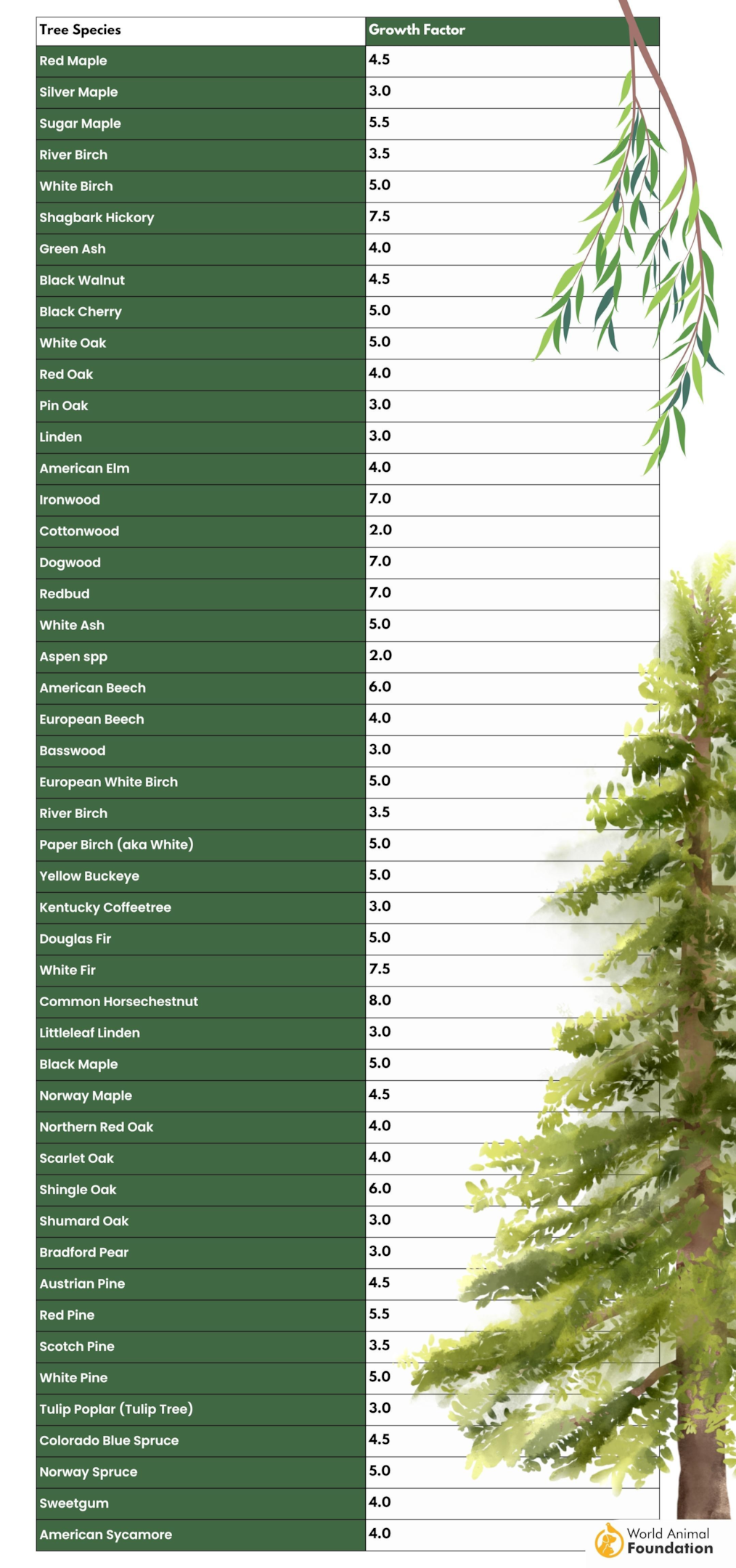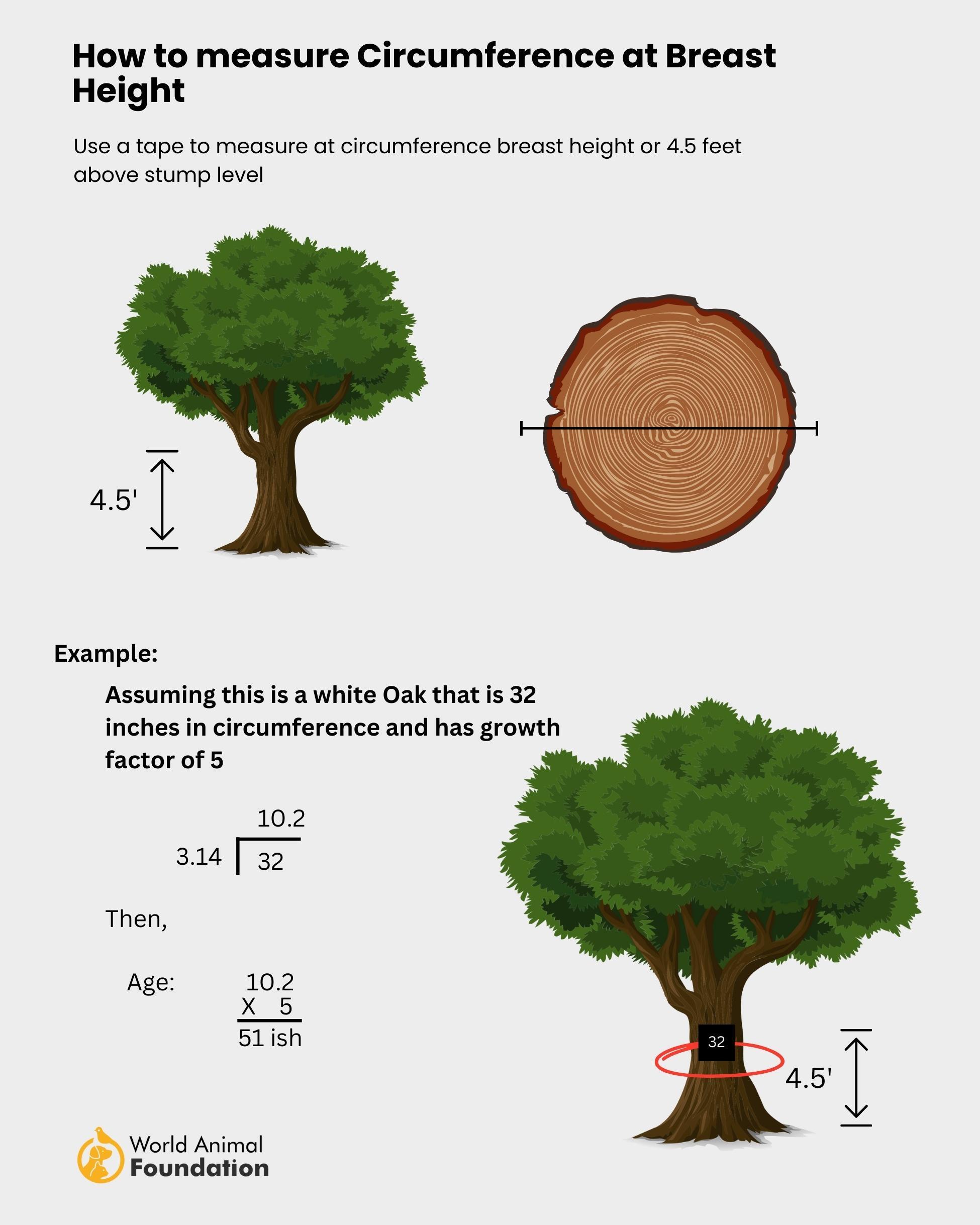Ever gazed upon a majestic tree and wondered about its silent tales of time? Enter the tree age calculator: a magical tool that lets you unravel a tree’s years without ever making a cut. It’s like unlocking the secrets of a wooden time capsule, one that’s been standing tall, witnessing the dance of seasons year after year.
How to Calculate a Tree’s Age
To calculate a tree’s age without cutting it down, the common method is to use tree diameter in combination with species-specific growth factors. This method provides a good estimate, though it might not always be exact.
The common formula is:
Age of Tree (in years) = Diameter of the tree (in inches or cm) x Growth Factor (specific to the type of tree)
Growth Factor (GF)
The growth factor is a species-specific value that indicates how much a tree grows in diameter each year. Different species of trees grow at different rates, so it’s important to use the correct growth factor for the species you are examining. For example:
- Silver maple has a growth factor of 3.0
- Pine might have a growth factor of 5.0
- American elm might be 4.0
- White oak has a growth factor of 5.0
- Red maple has a growth factor of 4.5
- Colorado blue spruce has a growth factor of 4.5

Calculating Diameter at Breast Height (DBH)
Diameter at breast height (DBH) is a standard method of expressing the diameter of the tree trunk or stem of a tree. “Breast height” is defined as 4.5 feet or 1.37 meters above the ground. To measure DBH:
- Use a measuring tape or a specific tool called a diameter tape.
- Wrap the tape around the tree at breast height and divide the tree’s circumference by π (approximately 3.14159) to get the diameter.
Calculating Circumference at Breast Height (CBH)
Circumference at breast height (CBH) is simply the measurement of the tree’s girth or circumference at the standardized breast height (4.5 feet or 1.37 meters above the ground). To measure CBH:
- Use a flexible measuring tape.
- Wrap the tape around the tree at the specified height to obtain the circumference.
General Insight to Tree Age Calculator
The tree age calculator considers various factors, including the species of the tree, its diameter or circumference, and growth factors. However, local growth rates and forest environment conditions like soil quality, water availability, and light exposure can also influence tree growth.
It’s essential to understand that tree age calculators can provide estimates, and direct methods like counting growth rings yield more precise results.
Type of Tree
Different tree species grow at different rates. For example, a pine tree might grow faster and have wider spacing between its growth rings compared to an oak tree. Therefore, the species is a crucial factor in estimating a tree’s age.
Over time, dendrologists and foresters have studied and recorded average growth rates for many tree species. This data helps in estimating age when other methods, like ring counting, are not feasible.
CBH (Circumference at Breast Height)
CBH is a standard method of measuring the girth of a tree. “Breast height” is typically defined as 4.5 feet (or 1.37 meters) above the ground.
Measuring the circumference of a tree at a standardized height ensures consistency across measurements and allows for comparison between trees or for use in age estimation formulas.
CBH is commonly used in forestry, dendrology, and environmental science. It provides an easily accessible and non-destructive way to gauge a tree’s size.

What’s the Method for Determining the Age of Any Tree?
Determining the age of a tree can vary depending on the specific circumstances and the precision required. Here’s a summary of common methods used:
- Counting Growth Rings: This is the most direct method for trees that produce annual growth rings.
a. Core Sampling: A tool called an increment borer is used to extract a core sample from the tree without causing significant harm. By counting the rings in the core sample, you can determine the estimated age of the tree.
b. Stump Counting: If a tree has been cut down, you can count the rings directly on the stump.
- Use of Historical Records: If there are historical records or photographs of when the tree was planted, these can be used to determine the tree’s age.
- Size Estimation: For some species, you can estimate age based on the size (diameter or height) of the tree. Tree age can be estimated using girth. Measure the trunk’s girth about 1m from the ground. Divide girth by 2.5 for age in years. For instance, a 50cm girth means around 20 years old.
- Carbon-14 Dating: This is typically used for very old trees or wood samples, especially when counting rings is not possible. The radioactive isotope carbon-14 decays over time, and by measuring the amount remaining in a sample, you can estimate the time since the tree absorbed that carbon during photosynthesis. This method is most commonly used in archaeology and paleontology.
For most common purposes, core sampling and counting growth rings is the preferred method. It’s worth noting that not all tree species produce distinct annual rings, so local knowledge of the species and its growth patterns is essential.
If you’re interested in dating a specific tree, consult a local arborist or dendrochronologist (a scientist specialized in dating tree rings) to get precise results.
FAQs
Does a Tree Die from Old Age?
Not directly. Trees don’t die of “old age” like humans but can become more susceptible to diseases, pests, and environmental stressors as they grow older.
How to Recognize Fast-growing Trees?
Fast-growing trees typically have smoother bark, wider spacing between annual growth rings, and they often reach maturity quicker than slow growers. Common fast-growing trees include willows, poplars, and some species of pines.
How to Determine the Age of a Tree without the Need to cut it down?
Use an increment borer to take a core sample from the tree and count its growth rings.
How Old is a Tree with 5 Rings?
A tree with 5 rings is typically 5 years old.
How to Calculate the Age of a Black Cherry Tree by Diameter?
This requires knowledge of the tree’s average growth rate in diameter per year for a given region and conditions. Once you have this rate, you can estimate the age by dividing the tree’s diameter by the average yearly growth rate. However, this method is an estimation and not as precise as counting growth rings.
Conclusion
A tree age calculator is like a time machine for the forest. With just a few measurements and the knowledge of a tree’s species, we can unveil the estimated age of a tree. While it may not replace the exactness of counting each growth ring, it offers a non-invasive peek into a tree’s life, reminding us of the enduring history and stories that old trees silently hold within their bark!


